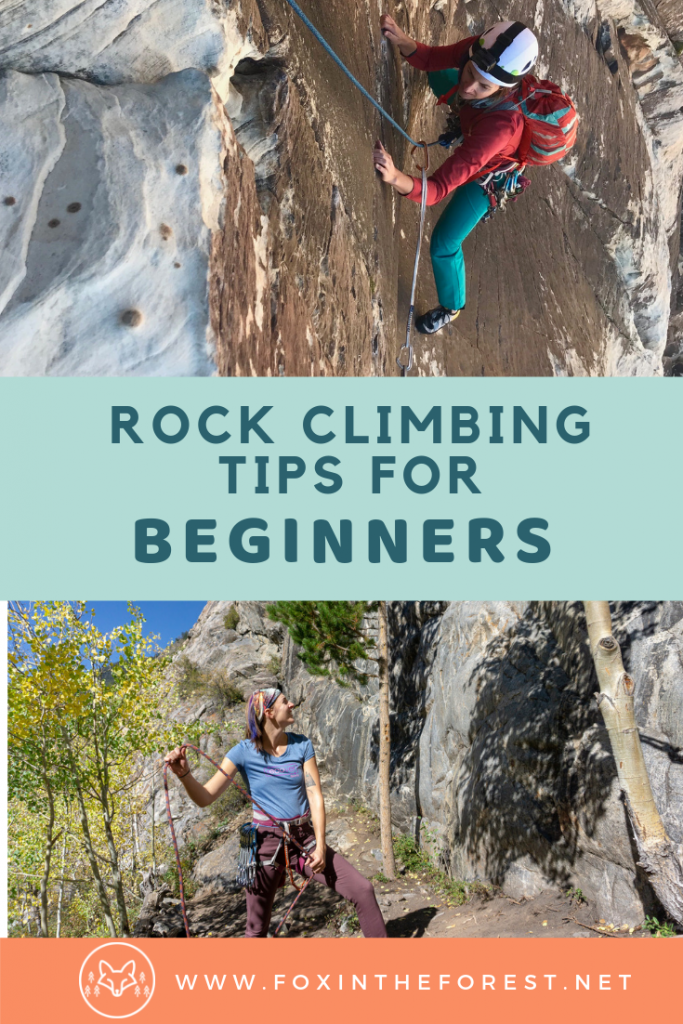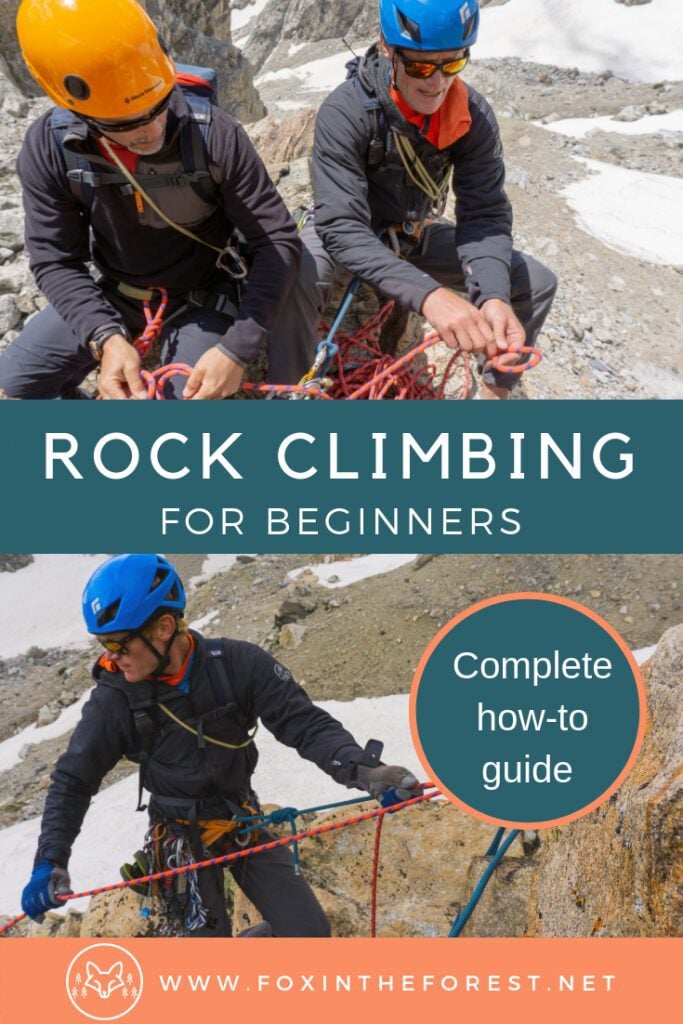Last Updated on December 20, 2023 by foxintheforest
Up until this year, I would never describe myself as a rock climber. Despite having nearly four years of experience under my belt, climbing is a sport I’ve always struggled with. It’s a rough activity, requiring you to see past your most basic sense of self-preservation. But alas, here I am hitting the crag three times a week. Here’s your rock climbing crash course for beginners. These tips are designed to give you the boost of confidence you need to start rock climbing.
Contents
Climbing Terms
Climbing Gear
Indoor Climbing
Climbing Technique
Climbing Knots
Training for Climbing
How to Start Lead Climbing
Optional Gear
Bouldering
Climbing Classes
Meet Other Climbers
Climbing Terms
I recently took a couple of friends out for their first climbing experience. The looked at me sideways as my partner and I examined possibly juggy routes for their first send. I laughed, not realizing that climbers speak their own language. Below are a few basic climbing phrases to be aware of.

Check me out flaking this rope, slingin’ draws and ready for some slab smearing.
Belay/belayer
Your belayer is the person in charge of your lifeline. The feed or take up rope as you make your way up the wall. Being a safe, solid belayer is at the heart of being a good climber.
ATC/belay device
A belay device is a piece of metal with a wire loop on it that attaches the belayer to the rope. This device uses friction to help aid the belayer in managing the weight of the climber.
Grigri
Pronounced: greegree. A type of belay device that uses pressure to stop the rope from slipping when weighted. It is a more advanced belay device, but typically safer.
Rappel
This is where you use a rope to lower yourself down from a high point that you cannot safely descend without some protection. It is a technique used in all types of climbing, from alpine climbing, to rock climbing and even canyoneering.
Grade
Refers to the difficulty of the climb. Here in the United States, we use the Yosemite system. For climbing, this rates on a scale from one to five. Once you hit five the grade differentiates from 5.4-5.15. For bouldering, we use a V grade designation from V-intro up to V15.
Pro/Protection
Refers to the devices and systems that keep you safe as you climb. These can be cams, hexes, nuts, tricams or bolts.
Top Rope
The easiest type of climbing and belaying. This is when the rope is above the climber at all times. The rope is fixed to an anchor at the top of the route. This can be done by someone leading a route first, or by walking up to an anchor from another location.
Lead Climbing
This type of climbing refers to the climber leading ahead of the rope, clipping into protection as they make their way up the wall. This type of climbing and belaying is more difficult and should not be attempted by beginners.
Sport Climbing
A type of lead climbing where the climber uses quickdraws to clip into pre-bolted routes on a rock wall. The bolts are permanent metal fixtures that are set into the rock by trained individuals.
Trad Climbing
Short for traditional climbing. This refers to the climber placing their own pro (cams, nuts, and wedges) into cracks or weaknesses in the rock as they go. Trad climbers do not typically use bolts.
Multi-Pitch
Refers to a type of climbing that is more than one rope length. Multi-pitch routes can either be trad or sport routes. Anchors are set at (hopefully) ideal locations such as ledges. One climber leads the route, the second climber follows up to the anchor and then the process starts again. These routes are typically tall and can be found either in the alpine or at the crag.
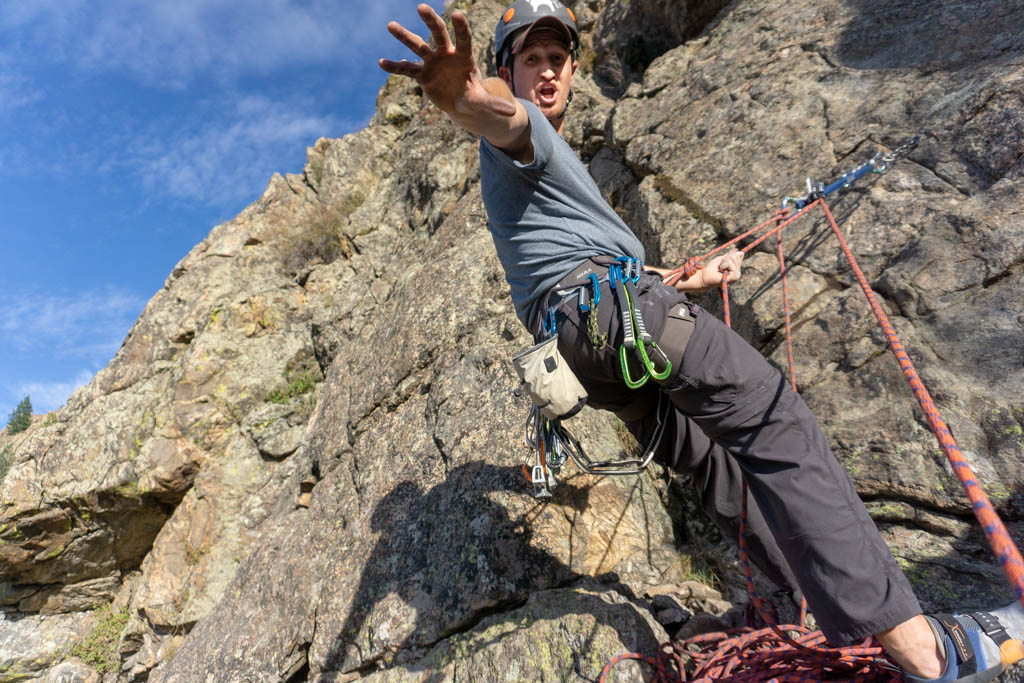
John goofing off at a belay station on a multi-pitch climb.
Alpine Climbing
Refers to roped climbing up a mountain. Alpine climbing is a thrilling sport where climbers are required to lead a route (typically trad) and their partner follows up a rock route on the side of the mountain. Many alpine climbs are multi-pitch.
Bouldering
Climbing shorter distances up big boulders. You are not roped in when you boulder, instead, you use crash pads and a spotter to help break a fall.
Scrambling
The act of climbing rock without a rope. Typically this refers to climbing in the alpine or in canyons. The difficulty falls between class 3 rock and class 4 rock (some easy class 5).
Free Soloing
The act of climbing roped climbing routes without a rope. Think Alex Honnold.
Crag/Cragging
Slang meaning either the climbing wall or the act of climbing.
Walk-Off
A climb where you can hike down the route, requiring no rappelling. Typical for trad climbing and some top rope.
Anchor
A safety system built at the top of a pitch, typically out of nylon or Dyneema slings, sometimes out of quickdraws.
Quickdraw
Two carabiners with a piece of webbing in between them. A type of protection used in sport climbing.
Cleaning
The act of taking down non-permanent protection on a lead route.
Jugs
A type of hold that has a lot of grip, is deep, and easy to hold.
Bomber
Slang for when the rock is stable and great for climbing
Crimpers
Tiny holds where you crimp your hands to grip, sometimes only holding on by your finger pads. A personal favorite of mine.
Slopers
Holds that slope towards you, making them difficult to grab and usually requiring you to either palm the hold or manipulate your center of gravity.
Smearing
A footwork technique where you raise your foot high and press into a vertical wall surface to gain traction.
Stemming
A climbing technique where you spread your feet across two rock faces at different angles, often used in canyoneering, chimney climbing and diahedrals (two rocks coming together at an angle like a partially opened book).
Take
A command meaning, take in the slack on the rope. Used when you need to take a break.
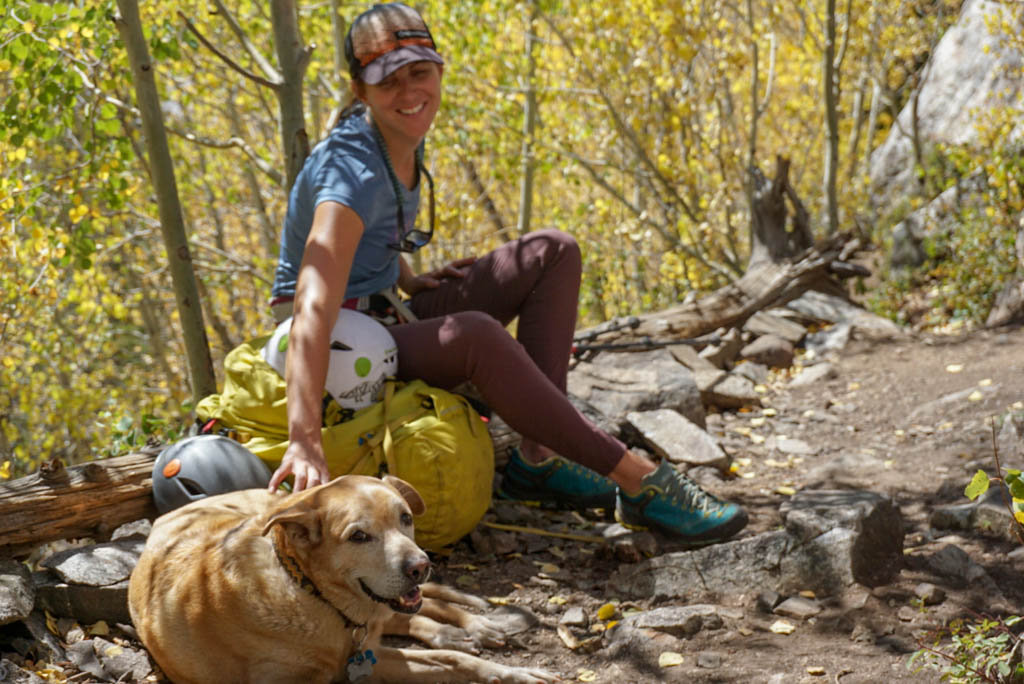
Let’s face it, crag dogs are half the fun of climbing. Am I right?
Up Rope
A command that means pay attention, there’s a lot of slack in the line. Used in top ropping.
Figure eight knot
A self-tightening knot used to tie into a rope.
Clove hitch
A hitch knot used to secure yourself to an anchor in multi-pitch climbing.
Send
Slang for climbing a route and finishing it.
Pulling Plastic
Slang term for climbing at a gym.
What gear do I need to start rock climbing?
When you first get started with rock climbing, you can easily rent or borrow your gear. At the very least, you should have a harness, chalk bag, chalk, climbing shoes, helmet (if you’re climbing outdoors) and a belay device or ATC. Often times, you can purchase these items as a package (minus the shoes). Climbing gear isn’t cheap, so don’t worry about a rope, anchoring systems, draws and pro just yet – instead opt to climb with a more-experienced friend who can mentor you with climbing. Once you’ve got some experience under your belt, feel free to purchase the rest of the gear.
How to select beginner rock climbing gear
Climbing gear should be selected based off of your height, weight and shoe size. Beginner harnesses are typically heavier, but still just as comfy as a lighter harness. When it comes to footwear, you’ll likely start with a flatter shoe in the beginning. Be warned, climbing shoes are not meant to be comfortable, they should fit just past snug, but your toes should not be folded over themselves. The reason for the uncomfortable footwear is due to the shape of the shoe. Shoes are meant to help you grip the rock, which leads to an uncomfortable position when standing. Frustrating, I know, but expect your shoes to be a bit uncomfortable. However, they shouldn’t be painful and you shouldn’t experience any pressure or discomfort when climbing.
How to get good deals on beginner climbing gear
This is a toughie. First and foremost, you should never, EVER purchase a used harness, protection, or rope unless you know the entire history of that system (which is usually never). This is because the gear may be used beyond its expiration date or has endured heavy use and is no longer safe to use. For good deals on climbing gear, try purchasing past-season gear (new) in the winter months. Climbing gear doesn’t go on sale very often, so whenever a store has an end-of-season sale, scope the climbing section. Alternatively, some gym memberships offer discounts to their members at their store.
For more on how to select the best climbing gear, including a gear checklist, check out my climbing gear-tastic post!
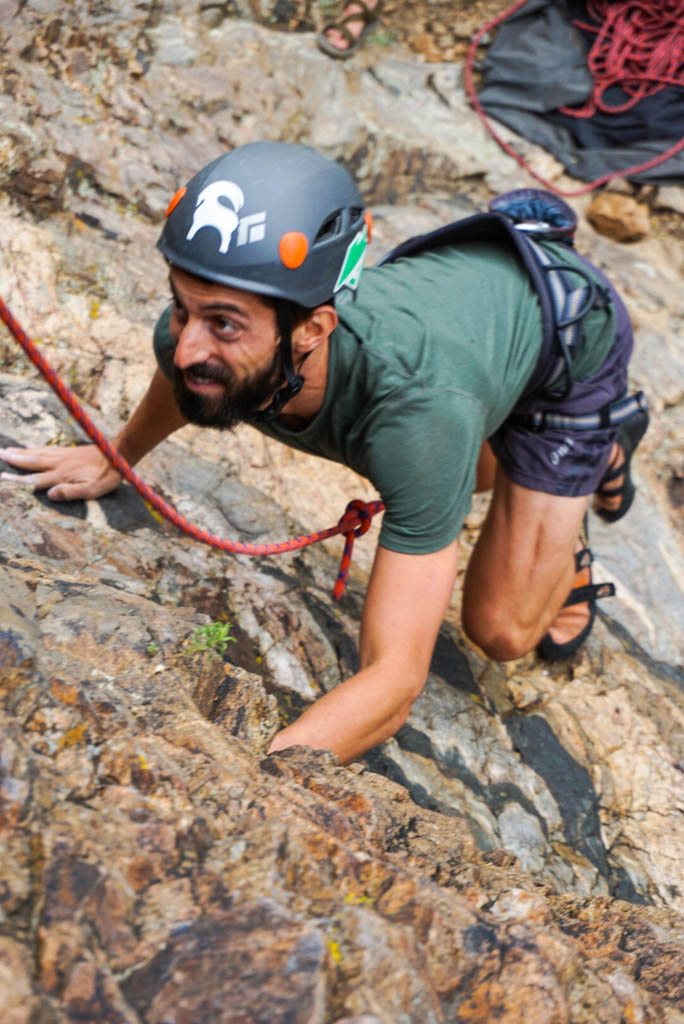
My friend JJ sending one of his first climbs!
How to safely inspect the climbing gear
Each time you climb, you’ll want to inspect your gear. Check your shoes and see if there are any rips, tears or cracks in the rubber. If an area looks well-worn, then consider getting your shoes re-soled (where the sticky rubber is re-applied). Once the rubber wears completely off you can’t resole the shoes, so it’s important to keep tabs on how your shoes are wearing over time, in order to get the most life out of them.
Prior to climbing, always inspect your rope. If you’re climbing with a friend’s rope, be sure to ask your friend if they’ve checked the rope. To do so, flake out the rope (run the rope through your hands and pile it neatly). Feel for any lumps, bumps or wear. Inspect any frays in the sheathing (outer part) for any core damage. A rope with core damage is not fit for climbing.
Next, inspect your harness. Look at the stitching and check for any missing stitching, rips, tears or frays. Inspect your climbing and belay loops, make sure nothing is torn or overly worn.
Care for your climbing gear
Nylon deteriorates in UV light, so be sure to store your climbing gear in a cool, dry place. When you’re on the crag, try not to step on the rope and keep the rope on a padded surface such as the sheet from a rope bag or towel. Wash your rope if it becomes excessively dirty in order to avoid dirt from deteriorating rope quality over time.
Replace any gear when:
- The rope has a core shot (the strength part of the rope has been compromised). If this happens near the end of the rope, you can cut the rope and still use it, just note the new length and don’t climb anything that won’t accommodate that length.
- The rope has taken the max number of falls. Climbing ropes are dynamic (meaning they stretch) and after a few big falls, the rope loses it’s elasticity, making falling on that rope dangerous. Each rope is different, so check with your rope manufacturer.
- You notice any rips, tears or excessive wear on your harness. Some harnesses change color with excessive wear.
- Your harness is more than six years old.
- You’ve taken a lot of large falls in your harness.
- Any webbing, nylon or Dyneema that has started to fray, been exposed to the sun for excessive amounts of time, or has taken large falls.
- Your quick draws begin to wear thin or have frayed nylon.
Start your climbing career at an indoor rock climbing gym
If you’re brand-new to rock climbing, you may want to start in a gym. Gyms are safe places in controlled environments where you can learn how to climb and belay. Although climbing in a gym doesn’t directly equate to climbing outdoors, you’ll get a sense for what it feels like to climb on a roped system.
On your first few indoor climbs, focus on using your legs instead of your arms. If you try to climb with your arms, you’ll end up pumping out (exhausting your arms) quickly. Move your feet up and scrunch your body small, with your arms extended, butt out, and your shoulders engaged. Next, stand up and reach higher. Let your legs do all the work.
If heights make you nervous, climb up five feet or so and have your belayer take. Sit in your harness and let go of the wall, letting the rope hold you. Keep your feet against the wall for support and breathe. This will help you get comfortable sitting in a harness.
After you’ve made your first send, have your belayer take. Then let your belayer know you’re ready to come down by saying “ready to lower” lean back in the harness and sit, with your feet against the wall. Walk slowly down the wall as your belayer lowers you. If you feel unsteady, feel free to grab the rope with your hands for added support.
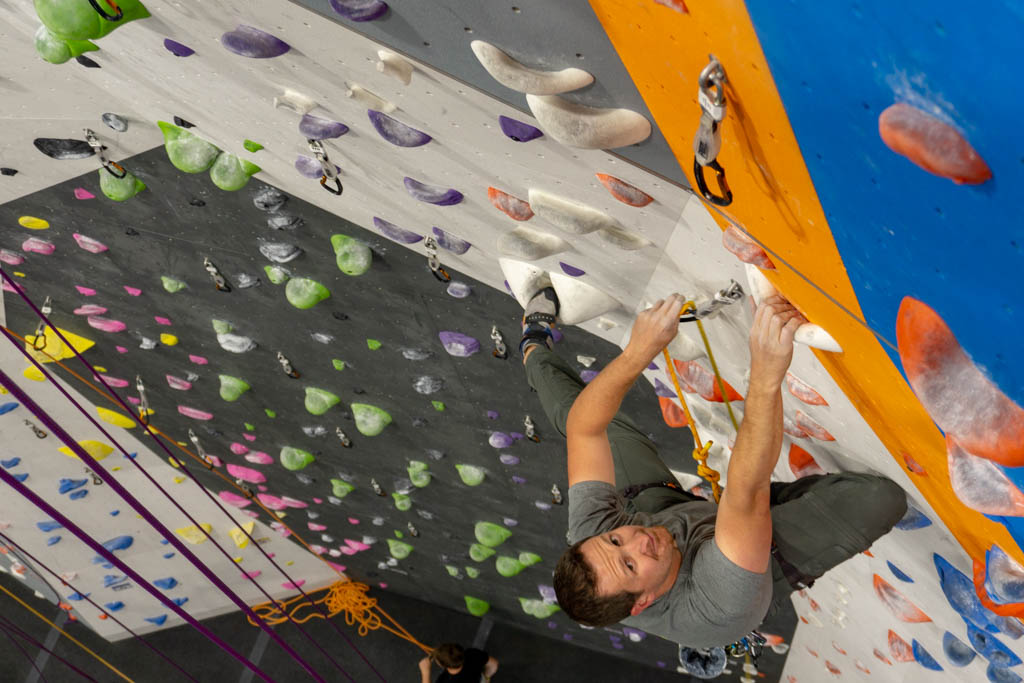
Climbing gyms are great places to push your boundaries and learn in a controlled environment.
How to deal with a fear of heights
All climbers deal with a fear of heights. Climbing is inherently counter-intuitive to our mind’s self-preservation system. A fear of heights is totally normal. There are several ways to combat this fear, but know that it takes time. Don’t beat yourself up if it doesn’t come instantly, it took me four years to feel comfortable. Remember, progress isn’t linear, you’ll have off days. Climber’s call their fear factor their “head game.” So when you’re unsteady at the crag just shrug and say, “Ugh, my head game is just off today.” Us climbers know that the struggle is real.
Psst: Get past your fear of heights, see how here.
Best Rock Climbing Techniques
We’ve already mentioned climbing with your legs (seriously, use those legs!), but there are a few other climbing techniques worth mentioning. Footwork is at the heart of a good climb. Your shoes are made of sticky rubber that’s designed to help you use your feet, even when there aren’t any obvious footholds around. Climbers are always hollering at one another to “TRUST YOUR FEET!” Fundamental footwork techniques are to get your feet high before making a move. Spreading them out when you need more balance, or flagging (putting your foot outwards and grazing the wall) when you need a counterbalance.
When you first begin climbing, you’ll likely be facing the wall as if you were climbing a ladder. However, some routes require different balancing techniques. If you can’t reach something or the holds are sideways, making them difficult to grab. Try turning your hip into the wall to get a better grab and enable your legs to stretch out further. Practice these techniques in the gym on a training wall to work on your craft.
What knots do I need to know for rock climbing?
When you first begin climbing you will need to know just a couple of knots to get started. As your climbing career takes off, there are more knots that will help you handle the different situations you’ll encounter on the crag. Here’s a look at the basic knots you’ll use in outdoor climbing:
- The figure eight knot and figure eight with a Yosemite finish**
- The overhand knot and double overhand knot**
- Double overhand knot (always tie the belayer’s end of the rope!)**
- Overhand on a bite
- Water knot
- Prussik knot
More advanced knots:
- The clove hitch
- The munter hitch
- The mule hitch
**Stared indicates the minimal knots you’ll need to top rope with a pre-set anchor.
I love Animated Knots for all of my climbing knot know-how. Check out their selection of videos and learn how to rope up safely.
How to train for rock climbing
Climbing is a total body workout. Hone your climbing muscles by training on a tension board, or climbing at the gym. If you lift weights, you’ll want to focus on your arms, shoulders core and legs (so pretty much everything). There are a wide variety of workouts for climbers, but it’s important to remember to train for those explosive movements.
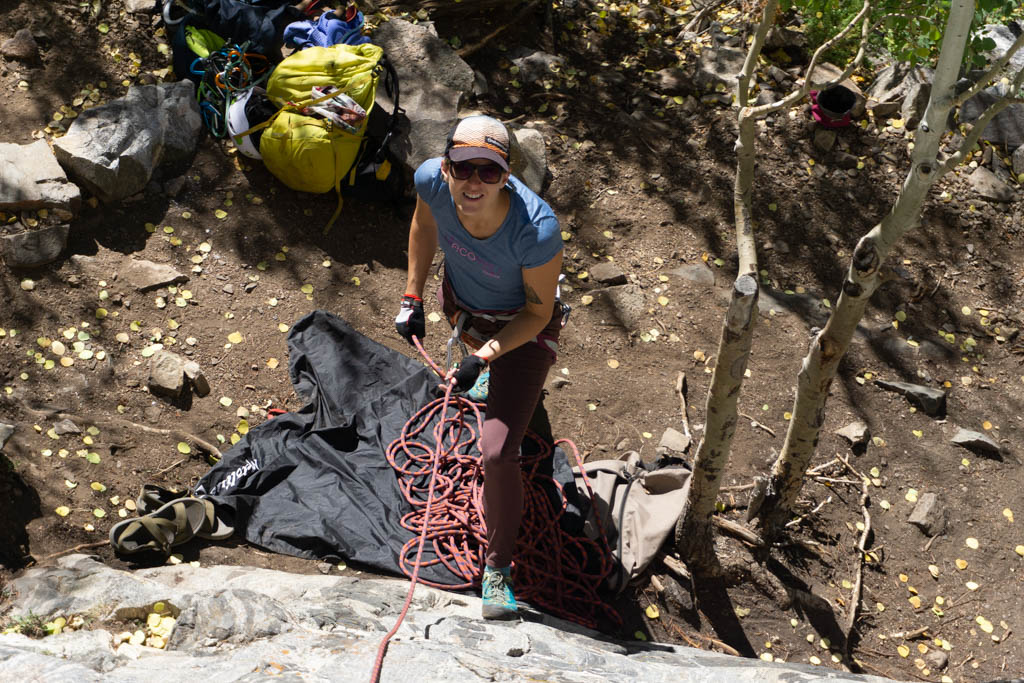
lead belaying is an important safety technique that every climber should learn when they are ready.
Transitioning from the Gym to Outdoor Climbing
Gym climbing and outdoor climbing don’t have too much in common. The colorful holds that tell you where to go next don’t exist outdoors. The point is, don’t get down on yourself if the transition is tough. It takes some adjusting. If you’re lost, look for chalky rock, that’s usually an indicator that a hold is nearby. If you see an “X” marked in chalk, that typically means the rock is unstable, avoid it! The last thing you want is for a rock to fall on your belayer.
Before you go, be sure to learn how to set a top rope anchor, or go with a more experienced climber. Don’t be afraid to ask, climbers are always happy to take out other people, it’s a social sport after all. To find routes, Mountain Project is a good place to start. Once you get familiar with an area, or you want more info, picking up a guidebook isn’t a bad idea either.
Oh, and it doesn’t matter if your on lead or top roping, always wear your helmet!
In Denver? Here’s a look at the best beginner routes in Clear Creek Canyon.
How to start lead climbing and belaying
Once you’re comfortable with top rope, it’s time to graduate to lead climbing. Since lead climbing is a dangerous activity, it’s best to learn from a professional. Most gyms offer lead climbing clinics where you learn about belaying techniques, proper clipping methods and how to fall.
Remember, lead climbing takes practice. Hone your skills by also tying into a top rope when you are first learning. That way you’ll have a safety backup. Once your climbing partner and you are ready to graduate to full-force lead sends, be sure to tone down the grade. Take practice falls and receive falls so you can hone your skills as both a climber and belayer.
Wanna get away? Here’s a look at a quick getaway, just two hours from Denver. Discover Vedauwoo, Wyoming.
What optional gear do I need to rock climb?
Once you gain more experience climbing, you can pick up a few key pieces of optional gear. Below are a few things I always take with me to the crag.
Approach shoes
These shoes are a hybrid hiker and climbing shoe. The toe often has sticky rubber to allow you to ascend the approach, scramble rock and even climb lower-grade routes. I summited the Grand Teton in approach shoes and find them highly useful when Alpine Climbing.
My Pick: Salewa Firetail EVO approach
Multi-pitch pack
It’s nice to have all of your gear in one place. If you get into multi-pitch climbing or alpine ascents a multi-pitch pack is a good investment. Look for a pack with a removable frame or no frame (nothing inhibits climbing like hitting your helmet on the frame of your pack). Multi-pitch packs are designed to be lightweight, compact, keep your center of gravity close and haul gear. A 30L pack gives you enough space to store some layers, water, snacks, ropes, and gear.
My Pick: Black Diamond Speed 30L (I own the 40L, but if you’re only using it for summer sends, the 30 is perfect)
Grigri
Once you’re comfortable with an ATC, you might want to consider upgrading to a gri-gri. These belay devices are safer if you know how to properly use them, since they have a built-in brake system. However, you can’t rappel with them in a safe manner.
My Pick: Petzl Grigri2
What Gear Do I need for Bouldering?
Bouldering offers a simpler climbing experience when it comes to gear. No knots, no ropes, no fuss. However, there are a few key pieces of gear that will allow you to send those pebbles!
Crash Pad
Rent, buy or borrow a crash pad if you plan on bouldering outdoors. In some cases you’ll need several pads, so don’t be shy about sharing.
My pick: Metolius Session Crash Pad
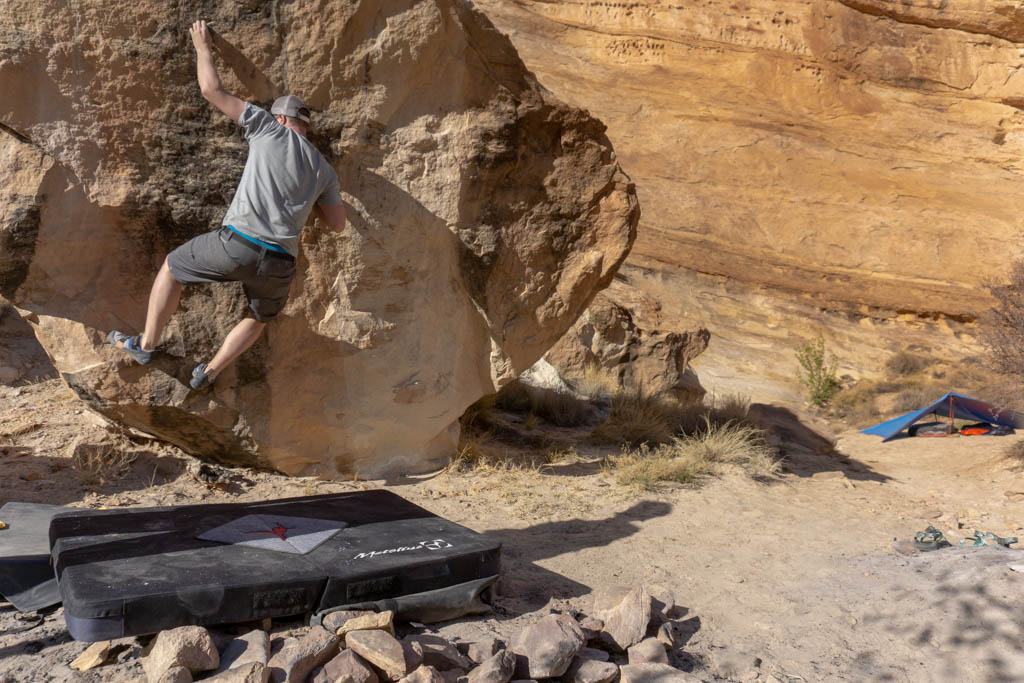
Bouldering helps improve climbing techniques, gain confidence for tough moves and even helps with scrambling and exposure.
Chalk/chalk bag
You can get a boulder-specific bag (bigger) or just use one that doubles up for roped climbing as well. Anything will work, I prefer something that shoes a little personality.
Climbing Shoes
Choosing a shoe is part art, part science, but be sure to get fitted professionally. I never believe in shoe recommendations, because every foot is like a fingerprint – it’s different. If you’re just starting out, select a less aggressive (more flat-soled) shoe. They are typically more affordable and more comfortable.
Brush
I personally don’t boulder enough to warrant a brush set, but some climbers love ‘em. Gyms often have brushes to get rid of pesky chalk build-up, but if you find yourself bouldering often and in popular areas, a small brush isn’t a bad investment.
Recommended Climbing Classes
As your climbing career starts to blossom, consider taking some courses. Even if you have a great mentor, a quick climbing techniques course at a local gym can help excel your game. For more advanced techniques, it’s best to learn from the pros, so you can be sure you’re safe. Many gyms offer free clinics for their members. These include how to safely belay (lead and top rope), climbing techniques, as well as outdoor skills.
Other options include hiring a guide (for custom learning, or taking a course with a certified AMGA rock guide) or learning from an outdoor club. Here in Colorado, I would recommend the following services:
- Colorado Mountain Club
- Colorado Mountain School
- Women’s Wilderness
- Earth Treks Climbing and Fitness Center
How to meet other climbers
To be honest with you, I’ve met 90% of my crag pals over the internet (the except really being my partner, Squirrel, who I met at work). There are a variety of ways to meet fellow climbers including Meetups, Facebook Groups, websites and forums, taking classes and more. As a woman, I truly enjoy climbing with my fellow ladies and folx. I’ve made some lasting connections via the following forums:
- Alpenglow Collective
- Outdoor Women’s Alliance Grassroots Team
- Women’s Wilderness
- Women-only Meetups
Remember, climbers are a social bunch. Be friendly and chatty on the crag – you’re bound to strike up a conversation with a friendly individual. Before you climb with someone for the first time, be sure to vet their skills. Ask them what grade they climb at and what their experience is. Ask if they are safety conscious. If you’re nervous (and that’s okay) head to a climbing gym or choose a lower-grade climbing area for your first meet up. Always be honest about your experience level and remember that you can always climb with people who are at different grades. However, knowing that information up front helps you determine someone’s ability to make sound decisions on the crag.
Now you’re ready to rock with this complete guide to beginner rock climbing. Reference this climbing crash course as you begin your climbing career. Be sure to check back every now and again, as I’ll be adding even more info in the future.
